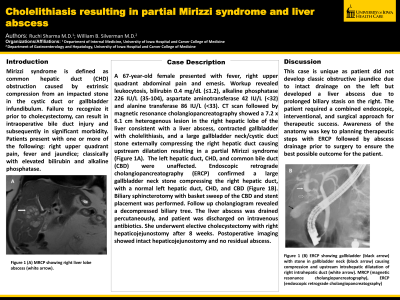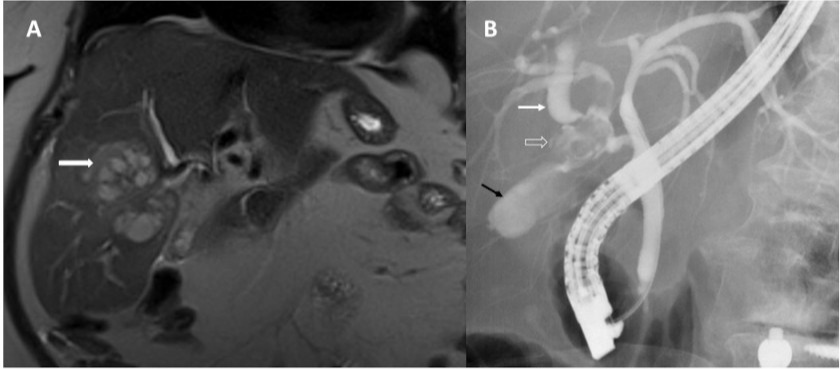Back


Poster Session D - Tuesday Morning
Category: Interventional Endoscopy
D0464 - Cholelithiasis Resulting in Partial Mirizzi Syndrome and Liver Abscess
Tuesday, October 25, 2022
10:00 AM – 12:00 PM ET
Location: Crown Ballroom

Has Audio

Ruchi Sharma, MD
University of Iowa Hospital and Carver College of Medicine
Coralville, IA
Presenting Author(s)
Ruchi Sharma, MD1, William B. Silverman, MD2
1University of Iowa Hospital and Carver College of Medicine, Coralville, IA; 2University of Iowa Hospital and Carver College of Medicine, Iowa City, IA
Introduction: Mirizzi syndrome is defined as common hepatic duct (CHD) obstruction caused by extrinsic compression from an impacted stone in the cystic duct or gallbladder infundibulum. Failure to recognize it prior to cholecystectomy, can result in intraoperative bile duct injury and subsequently in significant morbidity. Patients present with one or more of the following: right upper quadrant pain, fever and jaundice; classically with elevated bilirubin and alkaline phosphatase.
Case Description/Methods: A 67-year-old female presented with fever, right upper quadrant abdominal pain and emesis. Workup revealed leukocytosis, bilirubin 0.4 mg/dL (≤1.2), alkaline phosphatase 226 IU/L (35-104), aspartate aminotransferase 42 IU/L (< 32) and alanine transferase 86 IU/L (< 33). CT scan followed by magnetic resonance cholangiopancreatography showed a 7.2 x 6.1 cm heterogenous lesion in the right hepatic lobe of the liver consistent with a liver abscess, contracted gallbladder with cholelithiasis, and a large gallbladder neck/cystic duct stone externally compressing the right hepatic duct causing upstream dilatation resulting in a partial Mirizzi syndrome (Figure 1A). The left hepatic duct, CHD, and common bile duct (CBD) were unaffected. Endoscopic retrograde cholangiopancreatography (ERCP) confirmed a large gallbladder neck stone compressing the right hepatic duct, with a normal left hepatic duct, CHD, and CBD (Figure 1B). Biliary sphincterotomy with basket sweep of the CBD and stent placement was performed. Follow up cholangiogram revealed a decompressed biliary tree. The liver abscess was drained percutaneously, and patient was discharged on intravenous antibiotics. She underwent elective cholecystectomy with right hepaticojejunostomy after 8 weeks. Postoperative imaging showed intact hepaticojejunostomy and no residual abscess.
Discussion: This case is unique as patient did not develop classic obstructive jaundice due to intact drainage on the left but developed a liver abscess due to prolonged biliary stasis on the right. The patient required a combined endoscopic, interventional, and surgical approach for therapeutic success. Recognition of Mirizzi syndrome was key to planning therapeutic steps with ERCP followed by abscess drainage prior to surgery to ensure the best possible outcome for the patient.

Disclosures:
Ruchi Sharma, MD1, William B. Silverman, MD2. D0464 - Cholelithiasis Resulting in Partial Mirizzi Syndrome and Liver Abscess, ACG 2022 Annual Scientific Meeting Abstracts. Charlotte, NC: American College of Gastroenterology.
1University of Iowa Hospital and Carver College of Medicine, Coralville, IA; 2University of Iowa Hospital and Carver College of Medicine, Iowa City, IA
Introduction: Mirizzi syndrome is defined as common hepatic duct (CHD) obstruction caused by extrinsic compression from an impacted stone in the cystic duct or gallbladder infundibulum. Failure to recognize it prior to cholecystectomy, can result in intraoperative bile duct injury and subsequently in significant morbidity. Patients present with one or more of the following: right upper quadrant pain, fever and jaundice; classically with elevated bilirubin and alkaline phosphatase.
Case Description/Methods: A 67-year-old female presented with fever, right upper quadrant abdominal pain and emesis. Workup revealed leukocytosis, bilirubin 0.4 mg/dL (≤1.2), alkaline phosphatase 226 IU/L (35-104), aspartate aminotransferase 42 IU/L (< 32) and alanine transferase 86 IU/L (< 33). CT scan followed by magnetic resonance cholangiopancreatography showed a 7.2 x 6.1 cm heterogenous lesion in the right hepatic lobe of the liver consistent with a liver abscess, contracted gallbladder with cholelithiasis, and a large gallbladder neck/cystic duct stone externally compressing the right hepatic duct causing upstream dilatation resulting in a partial Mirizzi syndrome (Figure 1A). The left hepatic duct, CHD, and common bile duct (CBD) were unaffected. Endoscopic retrograde cholangiopancreatography (ERCP) confirmed a large gallbladder neck stone compressing the right hepatic duct, with a normal left hepatic duct, CHD, and CBD (Figure 1B). Biliary sphincterotomy with basket sweep of the CBD and stent placement was performed. Follow up cholangiogram revealed a decompressed biliary tree. The liver abscess was drained percutaneously, and patient was discharged on intravenous antibiotics. She underwent elective cholecystectomy with right hepaticojejunostomy after 8 weeks. Postoperative imaging showed intact hepaticojejunostomy and no residual abscess.
Discussion: This case is unique as patient did not develop classic obstructive jaundice due to intact drainage on the left but developed a liver abscess due to prolonged biliary stasis on the right. The patient required a combined endoscopic, interventional, and surgical approach for therapeutic success. Recognition of Mirizzi syndrome was key to planning therapeutic steps with ERCP followed by abscess drainage prior to surgery to ensure the best possible outcome for the patient.

Figure: Figure 1A: MRCP showing right liver lobe abscess (white arrow). B: ERCP showing gallbladder (black arrow) with stone in gallbladder neck (block arrow) causing compression and upstream intrahepatic dilatation of right intrahepatic duct (white arrow). MRCP (magnetic resonance cholangiopancreatography), ERCP (endoscopic retrograde cholangiopancreatography)
Disclosures:
Ruchi Sharma indicated no relevant financial relationships.
William Silverman indicated no relevant financial relationships.
Ruchi Sharma, MD1, William B. Silverman, MD2. D0464 - Cholelithiasis Resulting in Partial Mirizzi Syndrome and Liver Abscess, ACG 2022 Annual Scientific Meeting Abstracts. Charlotte, NC: American College of Gastroenterology.
